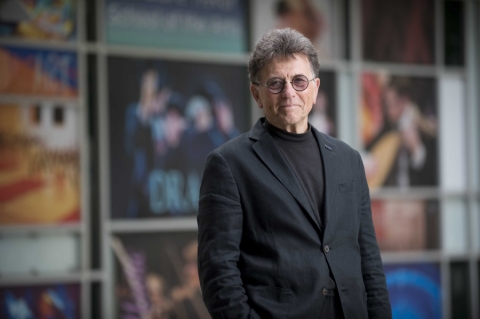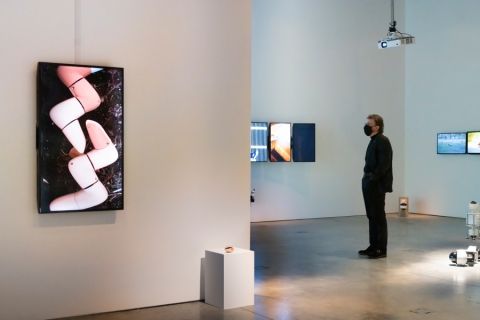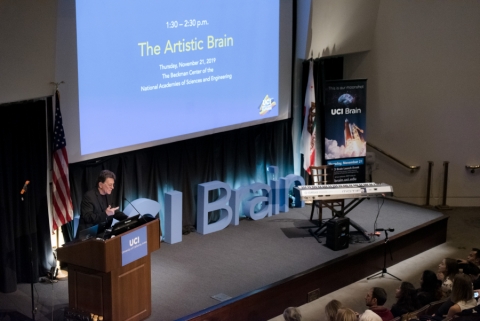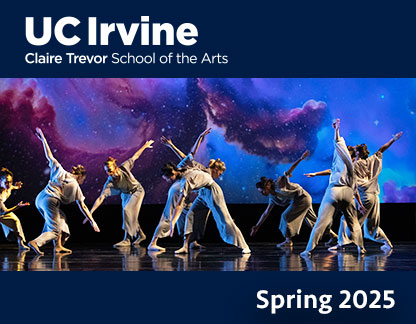Endowment Honors Stephen Barker’s Legacy
In honor of Stephen Barker’s retirement as dean of the Claire Trevor School of the Arts, friends and supporters are pitching in to create an endowment that will not only celebrate his legacy but also ensure future funding for interdisciplinary arts research – which has been at the heart of Barker’s 35-year career at UCI.
“Research and innovation in the arts are all around us, embedded in the cultural products that we produce, examine and enjoy,” says Jesse Colin Jackson, associate dean of research and innovation. “For CTSA faculty and students, research and innovation activities are the seeds that grow into creative excellence.”
From studying the science of movement to using technology to facilitate performances of musicians across continents, research and innovation elevate the arts at UCI.
The Stephen Barker Arts Research Endowment was established this year with founding gifts from Dean’s Arts Board members and longtime advocates Tom Nielsen and Cheryll and Richard Ruszat. They hope to inspire others to support the endowment, too – because they care about arts research, want to honor Barker, or both.
“Professional training in the visual and performing arts focuses on the skills necessary to attain proficiency in the various disciplines. But at a research university, scholarship constitutes the bedrock on which such practice relies, infusing it with its essence: aesthetics,” says Rick Stein, President & CEO of Arts Orange County, and another member of the Dean’s Arts Board who is contributing to the endowment. “Stephen Barker’s career as both a practitioner and a scholar exemplifies this synergy, and a research endowment is the perfect way to honor his long, distinguished service.”
Despite being one of the world’s richest countries, the U.S. lags behind other nations in funding arts and culture. Theater troupes, orchestras, operas, ballet companies and museums all depend on public support for their work, often leading artists to play it safe.
“It’s difficult to take risks as an artist of any kind, in the absence of support. So artists end up doing the safest thing within their discipline, be it a conventional gallery installation or restaging a popular theater production,” says Jackson.
Yet groundbreaking art tends to come from taking big risks, Jackson points out. In the 1970s, a cohort of avant-garde artists including M.F.A. student Chris Burden, who stuffed himself into a locker for five days as part of his thesis, helped put UCI arts on the map. Burden went onto an illustrious artistic career, producing a number of iconic works, including the Urban Lights installation outside of LACMA.
For the last several years, a grant program established under Barker’s leadership through the Institute for 21st Century Creativity (21C) has served as one of the school’s only funding programs for explicitly experimental work and collaborations between disciplines. Additionally, CTSA’s continued investment in the Experimental Media Performance Lab (xMPL), signifies an ongoing commitment to creating space and opportunities for leading-edge, interdisciplinary art. Both the xMPL and 21C are examples of programs that will receive support from the endowment.
“One of the hardest things about arts-based research projects is that there are a lot of unknowns,” explains Jackson. “If you’re producing some conventional choreography, you kind of know what the end looks like. This endowment will help us support projects where the outcome is a little less predictable, such as a dance experiment using new technologies that takes place in xMPL.”
The xMPL has a track record of spawning experimental projects that have drawn national and international attention. The 2019 Your Ocean, My Ocean, combined dance, theater and music under the direction of professor John Crawford to highlight the plight of our oceans. The performance was later expanded and restaged at Brown University. Also in 2019, professors Antoinette LaFarge and Annie Loui, in consultation with UCI neuroscientist Jim Fallon, produced Reading Frankenstein which layered brain imaging, digital projections, a virtual creature and live actors to explore the ethics of genetic engineering. Plans are underway to take the performance abroad. Similarly, Bryan Reynolds, Chancellor’s Professor and Claire Trevor Professor, wrote and directed Curie, Curie using dance, music and video performance to tell the story of Nobel Prize Laureate Marie Curie. This year, the work was reproduced in Curie’s hometown of Warsaw, Poland.
The beauty of an endowment is that all of the contributions go to the principal, which will never be spent – only the interest will be drawn each year. This allows the gifts to continue supporting arts research – and honoring Barker’s legacy – in perpetuity.
“Dean Barker wants to break the mold, break down the silos of disciplines, and push the outer edge of art-making,” says Ivan Williams, a filmmaker, UCI Foundation Trustee and Dean’s Arts Board member who is making a gift to the endowment. “The disciplines will blend, merge and form new shapes. That excites me, and I think that’s the mission Dean Barker has set for the school.”
That’s a mission that will live on as part of Barker’s legacy, thanks to the investments of CTSA’s donors and friends.
Image (top): Dean Stephen Barker stands in front of an art installation for the Ian Ingram exhibition in the Beall Center for Art + Technology.
To learn more and ways to support the Stephen Barker Arts Research Endowment, contact Sarah Strozza at 949-824-0629 or sstrozza@uci.edu.
CONNECT - Spring 2022
CONNECT – Spring 2025
- Make A Gift
- Giving Opportunities
- Ways to Give
- Support Groups
- UCI Giving Day
- Legacy Giving
- Brilliant Future Campaign




